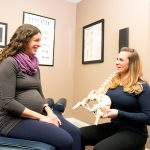Partnership for Postpartum Patients: Chiropractic and Pelvic Floor Physical Therapy
In life we need partnerships. This is especially true when it comes to specialties. Dr. Nelson specializes in prenatal and postpartum chiropractic care, but sometimes a patient needs extra care and attention. In those instances, she partners with pelvic floor physical therapist, Dr. Kiley Lester, PT, DPT, of Sierra Orthopaedic Physical Therapy.
“If I am working with a patient with pelvic pain or sciatic pain and they are not finding any relief after a few visits, I refer out to Dr. Lester because that is a sign to me that the patient may need internal work on the pelvic floor to help stabilize or return proper function to the pelvis,” Dr. Nelson says. “She is able to go internal and rehabilitate the part of the pelvis that chiropractic can’t get to alone.”
Postpartum care for moms is especially important because many women experience pelvic floor issues after giving birth. A weak pelvic floor can present with pain and heaviness and possible incontinence. Chiropractic can help by returning proper function to the pelvis and allowing full communication from the brain to the muscle group via the nervous system to start strengthening and rehabilitating the weak muscles. Conversely women can have a tight pelvic floor that can cause pain during sex, difficulty urinating or urinating a second time once you thought you were done, increased urinary tract infections (UTIs), and leaking when you sneeze, jump or lift.
When women have a very tight pelvic floor, they may need the expertise of a pelvic floor physical therapist who can work internally to help relax those muscles, lengthen the pelvic floor, and get mobility back in the pelvic and core muscles. Dr. Nelson also partners with Dr. Lester for patients who had an episiotomy or a c-section because Dr. Lester can mobilize scar tissue and help the abdomen heal. The internal and external work done can decrease numbness and get the regenerative growth going so that the patient heals faster.
Often with co-management, the patient will alternate visits between chiropractic and physical therapy, but the treatment plan and co-care varies based on the patient. With prenatal patients, the focus is usually to get the patient out of pain such as sciatica or lower back, and then working to keep the pelvis stable and aligned for labor. For postpartum cases when there is trauma involved – that could be scar tissue, emotional or physical trauma of giving birth – it takes a longer time to heal and generally the patient will see Dr. Lester more frequently or for a longer period of time.
When it comes to co-management of patient care, Dr. Lester really appreciates Dr. Nelson’s due diligence and gentle care.
“Dr. Nelson has never flared-up any of my patients,” Dr, Lester says. “Patients who come from Dr. Nelson have much better pelvic function.”
She goes on to say that some chiropractors try and manage pelvic floor issues themselves, but that Dr. Nelson has no ego in it and is always open to co-care and getting the best options for her patients.
“We really work to reach out and keep each other in the loop,” Dr. Lester says. “We keep to our specialties for the sake of the patient. Especially if it is a complicated case, Dr. Nelson will set me up as beautifully as possible and do all she can externally and then I take over to get the patient the additional release and healing they need.”
In addition to pelvic floor rehabilitation, Dr. Nelson works with postpartum women to rehab their diastasis recti through specialized breathing techniques. In fact, she is certified as a Postpartum Corrective Exercise Specialist (PCES), giving her the tools to rehabilitate postpartum women after giving birth. Doing breathing exercises and strengthening exercises for diastasis recti can help those separated abdominal muscles come back together and rebuild a strong core.
“It all starts with retraining your breath and introducing gentle stretches and exercises to correct postural changes to the spine and pelvis after the constant adaptive changes placed on the body from pregnancy. ” Dr. Nelson says.
If patients wait too long after giving birth to see Dr. Nelson, then the diastasis recti can get pretty extended or “settled” and she has to refer to physical therapy for more manual work and retraining of those abdominal muscles to come together. Physical therapy combined with Dr. Nelson’s breath work to retrain the diaphragm can really help strengthen the core for stability of the lumbar spine.
Depending on the patient and her needs, Dr. Nelson and Dr. Lester work as a well-oiled team – knowing when to let the other step in or be informed on behalf of getting the best results for their patients.





